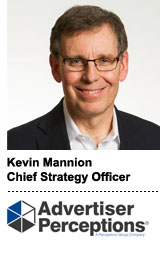 Aside from the Trade Desk, which outstrips competitors among agencies, independent DSPs still struggle to differentiate or break out from the pack behind the category killers, Google’s DoubleClick Bid Manager (DBM) and Amazon’s ad platform, in Advertiser Perceptions’ latest demand-side platform benchmark report released Monday.
Aside from the Trade Desk, which outstrips competitors among agencies, independent DSPs still struggle to differentiate or break out from the pack behind the category killers, Google’s DoubleClick Bid Manager (DBM) and Amazon’s ad platform, in Advertiser Perceptions’ latest demand-side platform benchmark report released Monday.
The report, based on a survey of more 700 execs – split evenly between agencies and marketers – found DBM and Amazon Advertising Platform tied with 38% overall adoption.
“But then there are a close cluster of six or seven companies with an interesting mix of approaches,” said Advertiser Perceptions Chief Strategy Officer Kevin Mannion.
The Trade Desk, for instance, is the only DSP tracked in the survey that “would show a dramatic difference if we broke out agencies and brands separately,” Mannion said.
Agencies consistently rank the Trade Desk at the top of their list, he said, but brand marketers tend to be neutral or unfamiliar. Eight percent of respondents characterized the company as a DSP and 26% as a DSP/DMP hybrid, while a third, mostly from the brand side, believe it to be an agency trading desk, a misperception that doesn’t harm the company because it primarily works with agencies.
For other DSPs too, lack of brand familiarity can actually be a good thing.
White labeling DSP technology to agencies or enterprise software companies like marketing clouds has been a way to maintain business with brands in-housing digital media capabilities, Mannion said.
Last year many brands were in the testing or consideration phase for in-housing media, he said, and now those numbers are starting to shake out.
Brands actively exploring in-housing technology dropped by 23% since the start of last year, with an additional 7% recommitting to outsourced technology and 16% transitioning to an in-house data and technology model.
The brand approach to in-housing is split roughly in three: those working directly with DSPs, with an agency and DSP or using an enterprise software solution.
Unlike agencies, which are being squeezed by consultancies and by in-housing adoption, DSPs are more often maintained as silent partners in the supply chain, Mannion said.
Keeping those brand relationships intact is crucial for the half dozen or so contender DSPs.
The Brand Pillars
Amazon and Google are particularly strong with brand-direct relationships.
Many brand marketers, even those with large media agency contracts, separately oversee most of the spend for self-attributing platforms like Google, Facebook and Amazon, Mannion said.
The average number of DSPs used by a marketer is steady at 3.3, but that often leaves only one or two seats at the table for independent solutions.
The industry has waited on mergers and acquisitions – or outright business failure – to thin out challenger DSPs, Mannion said, but those forecasts have been mostly unfulfilled.
Sizmek acquired Rocket Fuel last summer and Adobe bought TubeMogul in late 2016, but if anything those deals solidified the position of the two parent companies in a tightly packed group of DSP that includes The Trade Desk, MediaMath and AppNexus.
Programmatic budgets have consolidated to the top two players, he said, “but so far that consolidation and other selection trends haven’t winnowed out the next set of DSPs, where there’s a pretty open market.”













